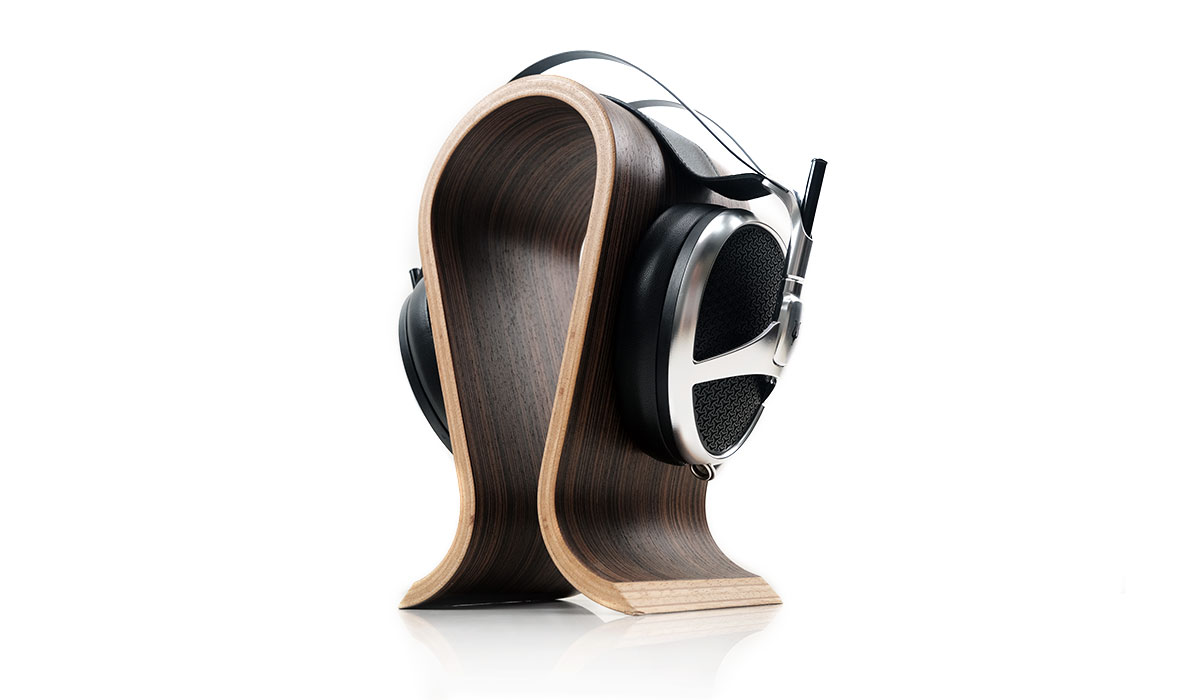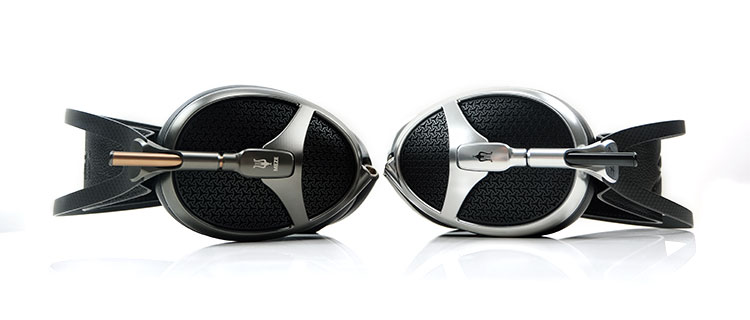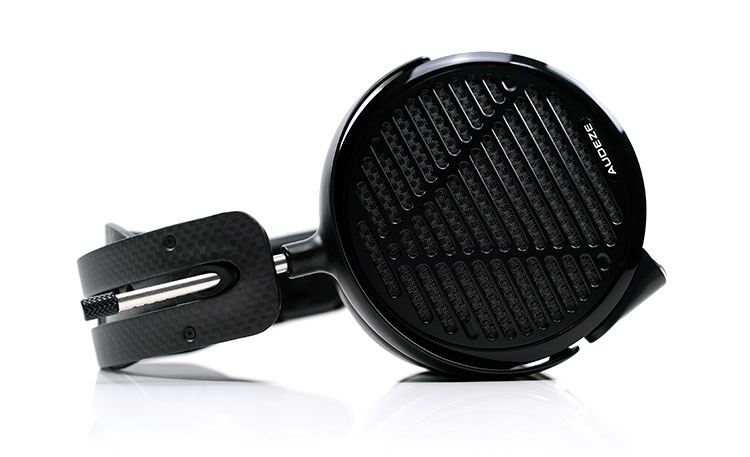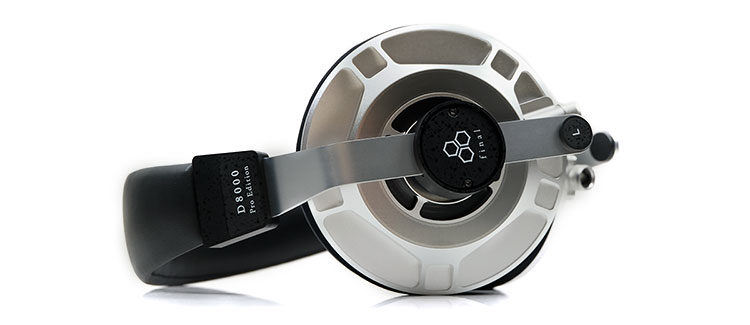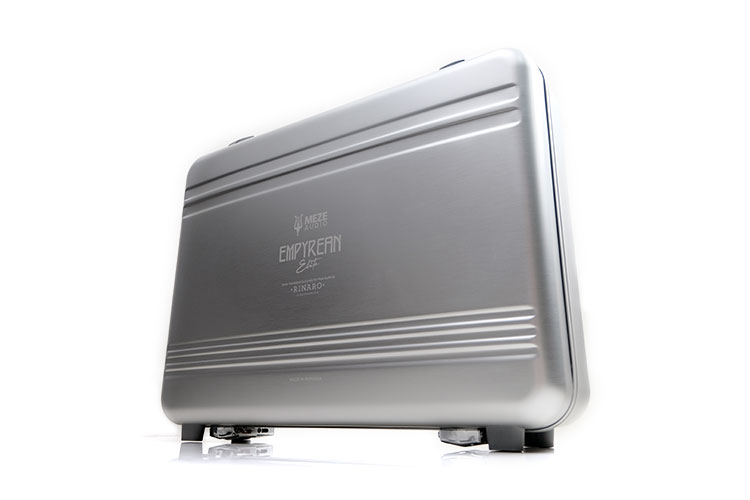Select Comparisons
Meze Empyrean
The Empyrean was Meze’s debut high-end or flagship headphones launched back in 2018 and a winner in our Top Gear Awards end of 2019. It is still for sale and has not been replaced by the Elite with both sharing a lot of similar technology.
$2999
Differences
The big differences between the two headphones boil down to the drivers with that new diaphragm inside the Elite called the Parus and its new semi-crystalline polymer film. The new diaphragm is lighter, thinner, and designed specifically with the Elite’s more reference tuning in mind.
The second difference is in the ovoid pad selection. Meze pads for both the Empyrean and the Elite are a quasi-extension of the driver magnetic field itself by housing an isodynamic magnetic alignment system so they play an important role in the driver performance and do have different tuning signatures.
In the case of the Elite, the original deep set leather pads have been changed to the new hybrid perforated Alcantara and leather pads that are not quite as deep at 25mm and have a wider inner cavity.
The final differences are aesthetical with the new silver aluminum frame finish, slightly lighter hue from the grill, and the Elite logo accents on the rod holder on each side as well as the Elite logo on the pressure strap.
In terms of efficiency, there is not much between them with the Elite officially rated at 32Ω and I dare say the Empyrean is the exact same though listed at 31.6Ω. The same also for SPL at 100dB for the Empyrean and 101dB for the Elite.
Shared Characteristics
In all other areas, the Empyrean and the Elite are more or less the same including the split coil trace design and hybrid magnet array system on the inside.
On the outside that also means the ovoid cup form factor, quasi-person dark grill design, the excellent lateral articulation on those pivot rods, the super-light carbon fiber headband system, and the comfortable shaped pressure strap. They also both weigh the exact same at 430g.
There is a nuanced difference in how they feel on the head when using the new larger cavity slimmer hybrid pads but with the older deeper Alcantara pads on both, they have a very similar fitting, as in very comfortable and no pressure spots.
Aesthetically, the big difference is the new silver finish to the CNC framework on the Elite compared to the copper and gunmetal hue of the Empyrean. The two headphones also come with similar stock OFC cable choices as well as similar Furukawa PCUHD upgrade cable options.
Performance
Ultimately, how you receive the differences between these two headphones depends on what you are looking for in a headphone. Do you go with the rich warm and dense embrace of the Empyrean, or the more neutral and cleaner tone of the Elite?
The Elite definitely delivers a lot more ‘information’ than the Empyrean. That means more resolution, better treble extension, a more accurate hi-fidelity timbre, and superior instrumental separation. The bass is also tighter, punchier, and cleaner with less bloat.
The Elite signature is also more immersive with an expanded soundstage, particularly the stereo imaging which pushes out a lot wider with more tangible shimmer on spatial cues that I like for detail enhancement.
Vocal performances on the Elite are still to the fore like the Empyrean but the better harmonic balance and micro-detail gives them some additional vibrancy and presence compared to the Empyrean which is a little softer and more rounded.
Lovers of the Empyrean sound signature might still miss that denser sound and weight of the original’s performance. Yes, the bass is a bit more bloated but it also sounds a little more planted which tends to work quite well for EDM and R’n’B.
The Empyrean low-end is not quite as punchy, a little softer in that regard, but the more intimate staging combined with the greater bass body can give a richer weightier sound to lower register instruments’ bass fundamental that is not quite there with the Elite.
Overall, I still think the Empyrean has its moments with a bass response that some current owners might find hard to give up. However, the Elite is the more balanced sounding, more genre flexible, and the more resolving of the two headphones.
Audeze LCD-5
The LCD-5 is Audeze’s new flagship planar headphone and one we recently featured last month. You can find the full review here.
$3999
Technical
The LCD-5 is something entirely new both inside and out from the previous LCD Series lineup. You could argue that the Elite is an evolution, at least from the outside and the core mechanics of how their ovoid isodynamic hybrid driver works but it also has received an entirely new diaphragm.
The LCD-5 comes with a new but more standard 90mm planar magnetic driver design if you could call it that. It is implemented with Audeze’s current Fazor waveguide, a nano-scale diaphragm thickness, as well as 14 Neodymium N50 magnets in a single-sided Fluxor magnet array.
Both companies have a specific focus on the trace patterns for their new driver designs with the Meze using the split could feature for the lows and highs then positioning the magnets in the hybrid array format to better deliver the mids and highs signal onto the ear canal.
For Audeze, the new driver had to be efficient, more so than the LCD-4. That meant a new trace pattern with varying width parallel traces that increases voltage headroom by altering the current density within each trace. The net effect is ideally improved control and lower distortion from the driver.
In terms of ratings, however, it is the Elite that wins the efficiency awards for SPL at 101dB compared to just 90dB but it is the LCD-5 that takes the impedance accolades at just 14Ω compared to 32Ω.
In our real-world testing using a Ferrum ORR and Holo Audio Spring 2 Wildism DAC, it was the Elite that was more current sensitive compared to the LCD-5.
Design
Both headphones are designed beautifully but with very different approaches. The LCD-5 design had weight as a big focus coming down from almost 700g of the LCD-4 to a very light 420g with practically every aspect redesigned to get there.
That includes a new slimline carbon fiber headband and thicker leather strap, wood replaced by a lighter ‘Tortoise shell’ dyed and polished acetate enclosure. AUdeze also removed the hefty pivot blocks for a new simpler rod adjustment system.
The Elite changes from the Empyrean are less dramatic but then if it is not broken then no need to fix it since it’s already 430g with an excellent pressure distribution system and an intricate and very articulate design to go with it.
It is really the comfort part that sets them apart and here the Elite is the comfier of the two. For vertical pressure, both are excellent actually with neither creating uncomfortable hotspots through their respective pressure strap systems. Rather it is the pad designs combined with the lateral clamping pressure that separates them.
For some, the lateral clamp of the LCD-5 will be stiffer compared to the more relaxed stance of the Elite. It feels more secure on the head but with the narrow contact points on the pads, it can be more fatiguing whereas the Elite remains very comfortable throughout.
A final note on the cable choices, I prefer the stock LCD-5 version, its finish and handling are more like the Elite’s Furukawa PCUHD upgrade cables.
Performance
The Elite will scale better on weaker sources whereas despite the improved efficiency of the LCD-5 over the LCD-4 it still requires more power to sound optimal as well as a more studied process in initial amp matching.
For me, the Elite floats among sources both portable and desktop with equal ease but sounds at its best with a punchy energetic solid-state amplifier such as the Bartok or the sweet expansive sounding Xi Audio Formula S. The LCD-5 has a slight bias to a tube amp setup such as the Auris HA-2SF but a smoother natural sounding solid-state works very well also.
Tuning
In terms of tuning, more and more these days manufacturers are chasing the Harmon Target curve and these two certainly aim to deliver something close to that. However, there are some differences in the final presentation.
The Elite is more on the south side of the curve running a few dB below through the mids and a few dB above on the mid-bass to give it a punchier low-end combined with a relaxed natural midrange coloration. It also tends to deliver a more ethereal high-fidelity but smooth overtone within a grander soundstage compared to the LCD-5.
The LCD-5 curve runs a few dB above the Elite through the mids from 600Hz to 3k with that classic Audeze lower-mids rise for instrumental presence. It has a flatter mid-bass tuning just below the curve so less of a punchy coloration from its low-end response.
However, the solid sub-bass reach and lower-mids presence compensate to deliver a little bit more solidity and definition. The LCD-5 will deliver a more immersive but rounded staging quality. Its instrument arrangement and clarity are more focused sounding to my ear despite the reduced stage size.
Both have a forward vocal presence but with the LCD-5 running a few dB higher through the upper mids vocals will command more of your attention. Of the two headphones, the LCD-5 will present the more intimate and robust vocal imaging.
The LCD-5 mids timbre doesn’t catch too much of a hard-edged odd-harmonic overtone though with a slightly relaxed 5-7k lower treble keeping harmonics clean but balanced. The Elite flips it with more 5-7k presence and a slightly diminished upper-mids presence which keeps the timbre lighter and more relaxed sounding.
Final D8000 Pro
$4299
The flagship Final D8000 Pro was reviewed by yours truly earlier this year and I rate it as a planar magnetic headphone with a world-class performance as well as a price point not too far off the Elite.
Technical
Inside, the D8000 Pro does not have a particularly large planar driver at 50mm, however, Final does not state the active area size, rather the overall dimension. The 4650mm2 active area of the new Elite driver is squared millimeter and definitely not the physical width of the driver.
The driver implementation is also quite unique for each headphone. The Elite uses a low mass semi-crystalline polymer film diaphragm over an ovoid driver enclosure with that split-coil trace design and hybrid magnet array system for mids and high clarity.
The D8000 Pro uses an AFDS implementation or Air Film Damping System to ensure there is zero contact between the diaphragm and the magnet array when active to enhance ‘bass purity’ or reduce distortion. The use of air film between the magnets acts like an air buffer and cushions the diaphragm in such a way as to reduce the level of contact with the magnets.
On paper, the D8000 Pro is the harder of the two to drive with more resistance at 60Ω compared to the Elite’s 32Ω and a slightly lower SPL also at 98dB compared to 101dB. In real-world testing I found it to run a few dB higher than the Elite on decent desktop amps such as the Bartok and the V590.
Design
I really like the stability and sturdiness of the D8000 Pro design. Combined with its retro HP-1 and HP-2 Yamaha legacy aesthetic it cuts a unique look despite its traditional circular cup and single leather headband form factor.
However, the Elite is the more attractive-looking design for me, as well as being the more comfortable of the two headphones. The ovoid design has always worked better for me, be it DCA’s Stealth, Hifiman’s Susvara, and not the Empyrean and the Elite. My ears just seem to fit better into the elongated cavities compared to the classic circular openings.
There is more to it than that, however. The D8000 Pro fitting was a big improvement on the slack pads and long headband of the original D8000. However, it’s still a big and heavier headphone at 523g and you feel that vertical pull more so than the Elite’s pressure strap system. For me, the Elite pressure balance and thicker pads are the better of the two implementations.
For the cables, the D8000 Pro 3m OFC silver coated wire cable is beautiful but heavy and single-ended only. It is hellish expensive at $799 on its own which is almost double the cost of the Furukawa PCUHD upgrade cables that come with the Elite.
Performance
While the Elite has toned down a lot of the coloration from the Empyrean to get a cleaner more accurate sound, it still is not at the neutral reference level tuning of the D8000 Pro.
There is a greater emphasis on detail and speed from the D8000 Pro. It is more revealing with an emphasis on micro-detail but less forgiving compared to the Elite’s smoother and more relaxed coloration.
The bass response on the D8000 Pro is flatter save for a small bump in the mid-bass whereas the Elite is stronger 80Hz to 300hz bump sounds fuller and punchier. The D8000 Pro low-end is very tight, transparent, and superbly defined. You will not miss one iota of information from the D8000 Pro tuning.
Through the mids, the D8000 Pro is more neutral in positioning with a cleaner but slightly sweet-sounding tone. The timbre does pull from a more extended and energetic treble tuning compared to the Elite which in turn highlights a lot more nuanced high-frequency micro-detail and imaging cues.
The Meze is more forward in the mids, with a stronger 1-3k rise with a fuller smoother vocal timbre but with slightly less upper treble influence on the upper harmonic order. The net result is a slightly softer note, slightly less micro-detail, but for many probably the more agreeable tone.
Staging wise the Elite does reach a bit deeper with comparatively more weight on the mid-bass to add to the warmth and quantity. The D8000 Pro extends really deep also but with less quantity, it’s all about layering and articulation here.
Height favors the D8000 Pro with an airy and cleaning tuning and excellent headroom post-10k. The Elite also has good headroom but it drops back the upper treble energy in keeping with its more relaxed sound signature.
Our Verdict
The Elite to me is like taking the excellent Empyrean, listening to some of the feedback over the last three years, and coming out with an even more likable and resolving flagship headphone.
For those that wanted more air and treble shimmer, it has that. Those who still wanted great vocal presence and that natural Meze house tone, you have that also.
The group that felt the bass was too dominant well bingo, you now have a tighter, more articulate, and refined sounding low-end. And finally, for anyone who wanted more staging presence, the Elite will surprise you.
And yet still within the confines of probably one of the most comfortable and well-built headphone designs I have reviewed in the last few years. Do not let that slightly heavier weight on the package fool you, there are lighter headphones but none as easy on the head as the Elite, (and the Empyrean).
The Elite is a step up but a step up in a very competitive high-end headphone market right now in 2021. Thankfully it has a unique sound signature that is I think many will embrace. Both portable and desktop audiophiles are included in that statement which is rare for flagship planars.
Meze Audio Elite Specifications
- Driver Type: Rinaro Isodynamic Hybrid Array® [MZ3SE]
- Operating Principle: Open
- Ear Coupling: Circumaural
- Frequency Response: 3 – 112,000Hz
- Impedance: 32Ω
- Nominal SPL: 101 dB (1mW / 1kHz)
- Maximum SPL: > 130dB
- Total Harmonic Distortion (THD): <0.05% (in the whole frequency range)
- Weight: 430g




